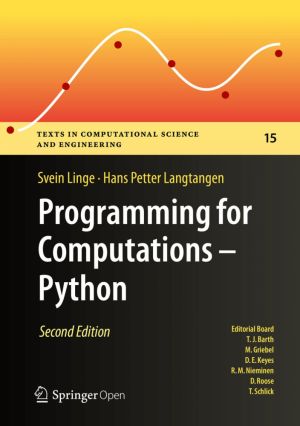Programming for Computations - Python
A Gentle Introduction to Numerical Simulations with Python 3.6
by Svein Linge, Hans Petter Langtangen
DescriptionTable of ContentsDetailsHashtagsReport an issue
The book was inspired by the Springer book TCSE 6: A Primer on Scientific Programming with Python (by Langtangen), but the style employed is more accessible and concise, in keeping with the needs of engineering students.
The book outlines the shortest possible path from no previous experience with programming to a set of skills that allows students to write simple programs for solving common mathematical problems with numerical methods in the context of engineering and science courses. The emphasis is on generic algorithms, clean program design, the use of functions, and automatic tests for verification. 






Book Description
This book presents computer programming as a key method for solving mathematical problems. This second edition of the well-received book has been extensively revised: All code is now written in Python version 3.6 (no longer version 2.7). In addition, the two first chapters of the previous edition have been extended and split up into five new chapters, thus expanding the introduction to programming from 50 to 150 pages. Throughout the book, the explanations provided are now more detailed, previous examples have been modified, and new sections, examples and exercises have been added. Also, a number of small errors have been corrected.The book was inspired by the Springer book TCSE 6: A Primer on Scientific Programming with Python (by Langtangen), but the style employed is more accessible and concise, in keeping with the needs of engineering students.
The book outlines the shortest possible path from no previous experience with programming to a set of skills that allows students to write simple programs for solving common mathematical problems with numerical methods in the context of engineering and science courses. The emphasis is on generic algorithms, clean program design, the use of functions, and automatic tests for verification.
This open book is licensed under a Creative Commons License (CC BY). You can download Programming for Computations - Python ebook for free in PDF format (7.3 MB).
Table of Contents
Chapter 1
The First Few Steps
1.1 What Is a Program? And What Is Programming?
1.2 A Python Program with Variables
1.3 A Python Program with a Library Function
1.4 Importing from Modules and Packages
1.5 A Python Program with Vectorization and Plotting
1.6 Plotting, Printing and Input Data
1.7 Error Messages and Warnings
1.8 Concluding Remarks
1.9 Exercises
Chapter 2
A Few More Steps
2.1 Using Python Interactively
2.2 Variables, Objects and Expressions
2.3 Numerical Python Arrays
2.4 Random Numbers
2.5 Exercises
Chapter 3
Loops and Branching
3.1 The for Loop
3.2 The while Loop
3.3 Branching (if, elif and else)
3.4 Exercises
Chapter 4
Functions and the Writing of Code
4.1 Functions: How to Write Them?
4.2 Programming as a Step-Wise Strategy
4.3 Exercises
Chapter 5
Some More Python Essentials
5.1 Lists and Tuples: Alternatives to Arrays
5.2 Exception Handling
5.3 Symbolic Computations
5.4 Making Our Own Module
5.5 Files: Read and Write
5.6 Measuring Execution Time
5.7 Exercises
Chapter 6
Computing Integrals and Testing Code
6.1 Basic Ideas of Numerical Integration
6.2 The Composite Trapezoidal Rule
6.3 The Composite Midpoint Method
6.4 Vectorizing the Functions
6.5 Rate of Convergence
6.6 Testing Code
6.7 Double and Triple Integrals
6.8 Exercises
Chapter 7
Solving Nonlinear Algebraic Equations
7.1 Brute Force Methods
7.2 Newton's Method
7.3 The Secant Method
7.4 The Bisection Method
7.5 Rate of Convergence
7.6 Solving Multiple Nonlinear Algebraic Equations
7.7 Exercises
Chapter 8
Solving Ordinary Differential Equations
8.1 Filling a Water Tank: Two Cases
8.2 Population Growth: A First Order ODE
8.3 Spreading of Disease: A System of First Order ODEs
8.4 Oscillating 1D Systems: A Second Order ODE
8.5 Rate of Convergence
8.6 Exercises
Chapter 9
Solving Partial Differential Equations
9.1 Example: Temperature Development in a Rod
9.2 Finite Difference Methods
9.3 Exercises
Book Details
Title
Programming for Computations - Python
Subject
Computer Science
Publisher
Springer
Published
2020
Pages
350
Edition
2
Language
English
ISBN13
9783030168766
ISBN10
303016876X
ISBN13 Digital
9783030168773
ISBN10 Digital
3030168778
PDF Size
7.3 MB
License

Related Books
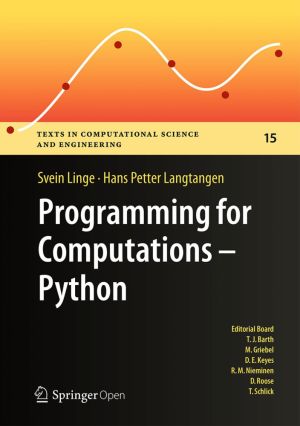
This book presents computer programming as a key method for solving mathematical problems. There are two versions of the book, one for MATLAB and one for Python. The book was inspired by the Springer book TCSE 6: A Primer on Scientific Programming with Python (by Langtangen), but the style is more accessible and concise, in keeping with the needs o...
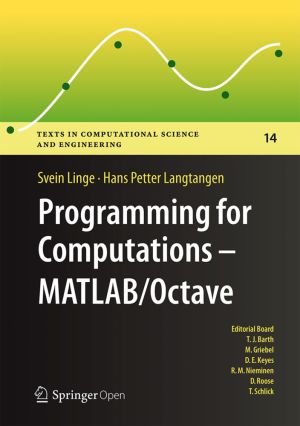
This book presents computer programming as a key method for solving mathematical problems. There are two versions of the book, one for MATLAB and one for Python. The book was inspired by the Springer book TCSE 6: A Primer on Scientific Programming with Python (by Langtangen), but the style is more accessible and concise, in keeping with the needs o...
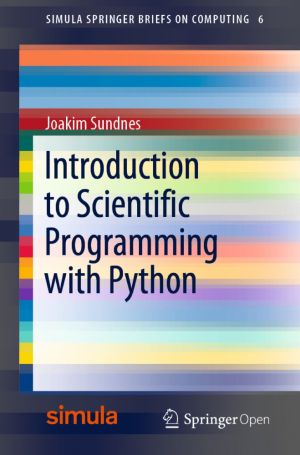
This open book offers an initial introduction to programming for scientific and computational applications using the Python programming language. The presentation style is compact and example-based, making it suitable for students and researchers with little or no prior experience in programming.
The book uses relevant examples from mathematics a...
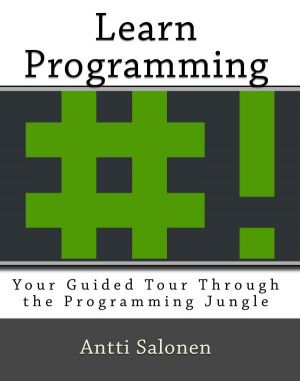
This book is aimed at readers who are interested in software development but have very little to no prior experience. The book focuses on teaching the core principles around software development. It uses several technologies to this goal (e.g. C, Python, JavaScript, HTML, etc.) but is not a book about the technologies themselves. The reader will le...
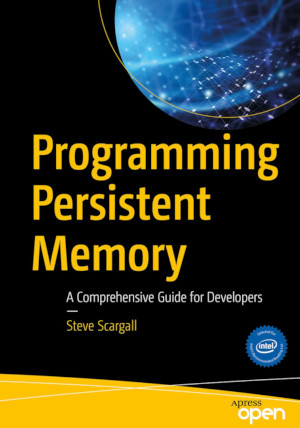
Beginning and experienced programmers will use this comprehensive guide to persistent memory programming. You will understand how persistent memory brings together several new software/hardware requirements, and offers great promise for better performance and faster application startup times - a huge leap forward in byte-addressable capacity compar...
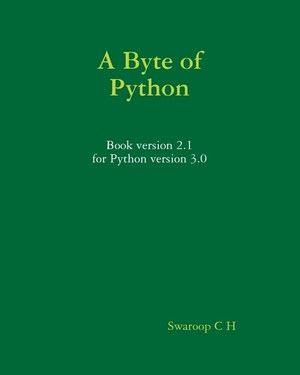
Python is one of those rare languages which can claim to be both simple and powerful. You will find yourself pleasantly surprised to see how easy it is to concentrate on the solution to the problem rather than the syntax and structure of the language you are programming in.
A Byte of Python is a free book on programming using the Python language...

